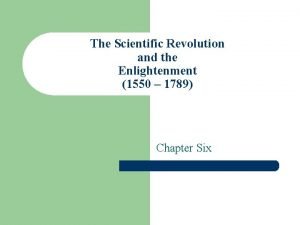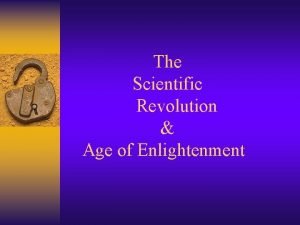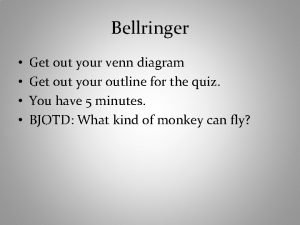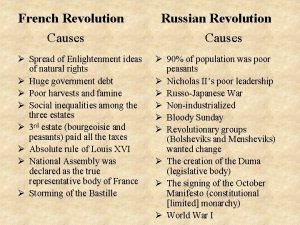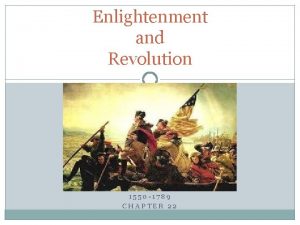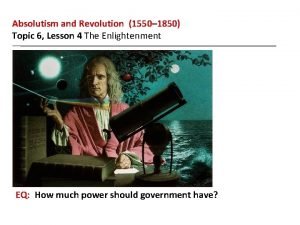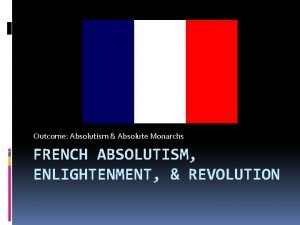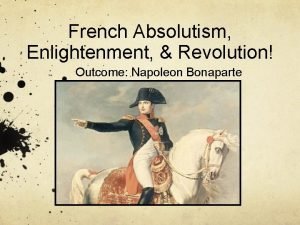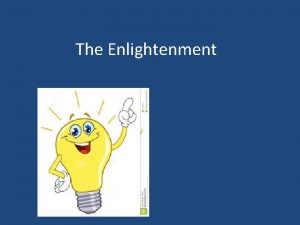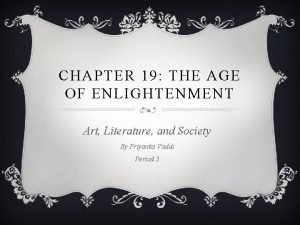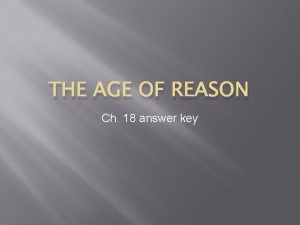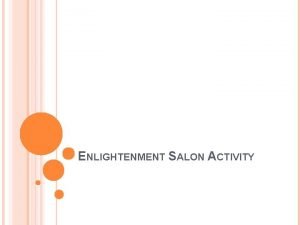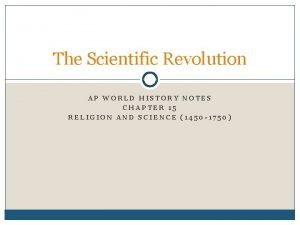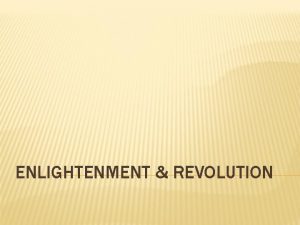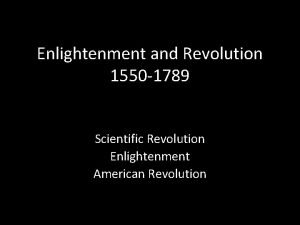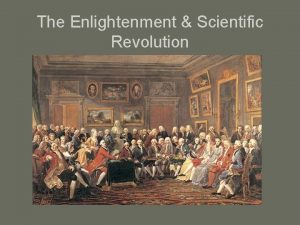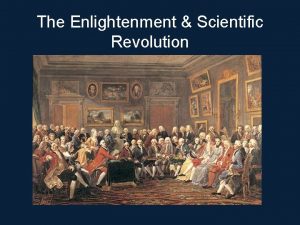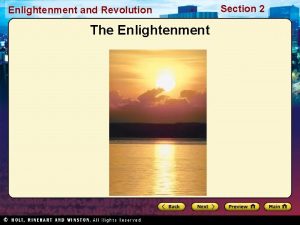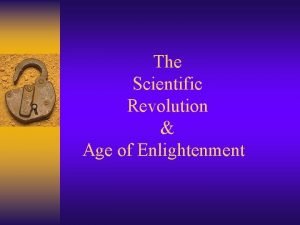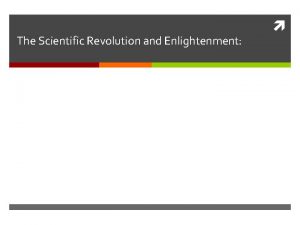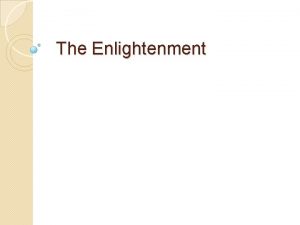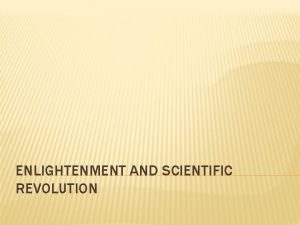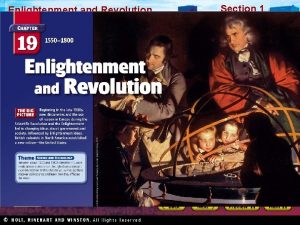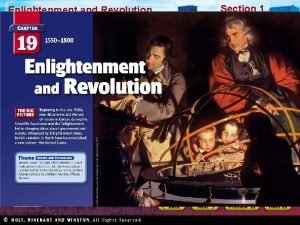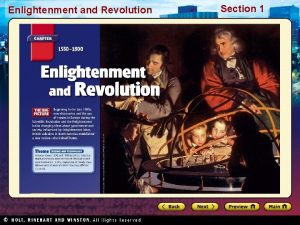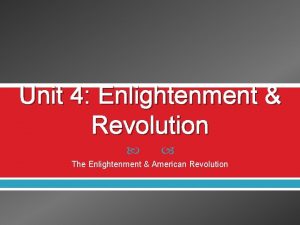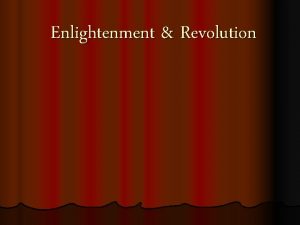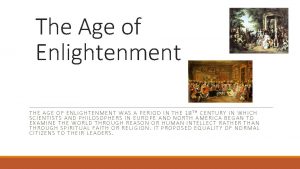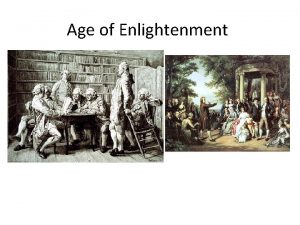The Scientific Revolution Age of Enlightenment Setting the





















- Slides: 21

The Scientific Revolution & Age of Enlightenment

Setting the Stage ¨ 1300 -1600: Great change in Europe ¨ Renaissance – rebirth in learning, spirit of curiosity ¨ Reformation – challenged accepted way of thinking about God and salvation

Scientific Revolution Enlightenment 1543 -1687 1715 -1789 Laid foundations of modern thought Built on those foundations Scientific Inquiry Reform Society No (Intentional) Challenge to Social Order Challenged Social Order/ Authorities Limited Scope Ambitious, Extensive Scope

The Roots of Modern Science ¨ What was the medieval view of the universe? Draw a model and describe.

Ptolemy Geocentric Theory

Scientific Revolution ¨ Mid-1500 s ¨ Based on careful observation ¨ Started with explorers & their discoveries - possibility of new truths to be found - new inventions led to scientific research ¨ Invention of the printing press - helped spread new ideas

Heliocentric Theory ¨ Nicolaus Copernicus - Polish astronomer - suggested that the sun was the center of the universe - feared that he would be ridiculed - did not publish his finding until 1543 - On the Revolutions of the Heavenly Bodies

Heliocentric Theory ¨ Johannes Kepler (1571 -1630) - mathematical laws govern planetary motion - planets revolve around the sun in elliptical orbits and not in circles

Galileo Galilei

Galileo Galilei ¨ 1564 -1642 ¨ With a telescope, Galileo saw sunspots, moons of Jupiter, mountains on the moon ¨ Theory of velocity of fallen bodies anticipated the modern law of inertia ¨ Finding scared Catholics & Protestants ¨ Church warns Galileo to not publish findings ¨ 1632, publishes book supporting Copernicus & Ptolemy ¨ Lived under house arrest until his death in 1642 ¨ 1992, Catholic Church acknowledges he was right

Scientific Method

Francis Bacon & Rene Descartes Using this video and Page 626, identify how each figure developed their own scientific methods Francis Bacon Rene Descartes

Francis Bacon & Rene Descartes ¨ Bacon attacks medieval scholars for relying on conclusions of Aristotle - Urged scientists to experiment and draw conclusions ¨ Descartes relied on using mathematics and logic - Only thing he knew for certain is that he existed – he said, “I think, therefore I am”

Francis Bacon & Rene Descartes

Isaac Newton & Law of Gravity ¨ ¨ Mid-1600 s English scientist Studied at Cambridge University Theory that all physical objects were affected equally by the same forces ¨ Law of Universal Gravitation - every object in the universe attracts every other object - degree of attraction depends on mass of object & distance be/ them ¨ 1687 – published The Mathematical Principles of Natural Philosophy - universe = giant clock: all parts work together - God was the clockmaker who set everything in motion

The Scientific Revolution Spreads Using pg. 627 -628, identify new ideas and discoveries as the Scientific Revolution spread throughout Europe in the chart in your notes. Be sure to identify the person responsible for the achievement.

The Scientific Revolution Spreads Scientific Instruments Biology and Medicine Chemistry

Effects… ¨ Prompted new ways of thinking – Scholars/philosophers reevaluate old beliefs – Use the scientific method to gain insights into the underlying beliefs regarding government, religion, economics, and education ¨ Prompted a new intellectual movement that stressed reason and thought and the power of individuals to solve problems – The Enlightenment

“What is Enlightenment? ” – Immanuel Kant ¨ Read the excerpt provided. ¨ How does Kant define “enlightenment”? ¨ How does his definition compare to other definitions of enlightenment we’ve used in our course?

What spread these ideas? ¨ Books ¨ Magazines ¨ Art ¨ Music ¨ Salons – social gatherings ¨ Word of mouth

Age of Reason Speed Dating ¨ Select a figure to research. Use your instruction sheet as a guideline. ¨ Prepare an information card to use as reference for tomorrow’s class. ¨ Props & Costumes will be EXTRA CREDIT! ¨ Participate in Speed Dating Simulation in class.
 Newton's first law of motion
Newton's first law of motion Enlightenment vs scientific revolution
Enlightenment vs scientific revolution Scientific revolution and enlightenment speed dating
Scientific revolution and enlightenment speed dating Hobbes and locke venn diagram
Hobbes and locke venn diagram Iron age dates
Iron age dates Iron age bronze age stone age timeline
Iron age bronze age stone age timeline Enlightenment ideals
Enlightenment ideals Chapter 22 building vocabulary enlightenment and revolution
Chapter 22 building vocabulary enlightenment and revolution Absolutism and revolution lesson 4 the enlightenment
Absolutism and revolution lesson 4 the enlightenment French absolutism enlightenment & revolution
French absolutism enlightenment & revolution French absolutism enlightenment & revolution
French absolutism enlightenment & revolution What is absolutism
What is absolutism French absolutism enlightenment & revolution
French absolutism enlightenment & revolution The new intellectual movement that stressed reason
The new intellectual movement that stressed reason Age of enlightenment art
Age of enlightenment art The enlightenment (age of reason) answer key pdf
The enlightenment (age of reason) answer key pdf Salon age of enlightenment
Salon age of enlightenment Russian revolution vs french revolution
Russian revolution vs french revolution How could the french revolution have been avoided
How could the french revolution have been avoided Third agricultural revolution
Third agricultural revolution The scientific revolution chapter 6 section 1
The scientific revolution chapter 6 section 1 Scientific revolution ap world history
Scientific revolution ap world history
